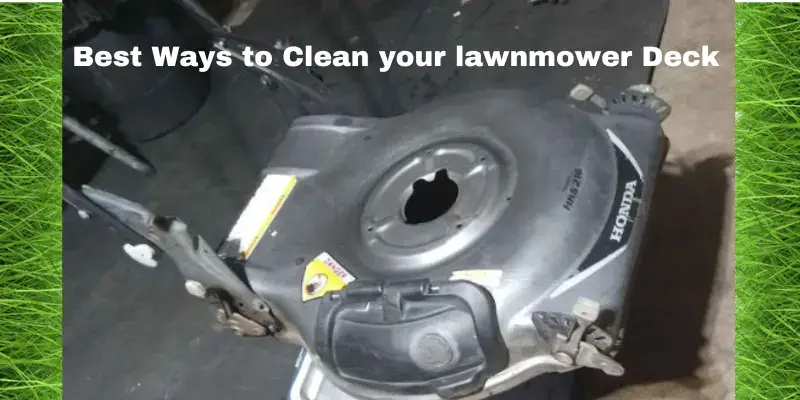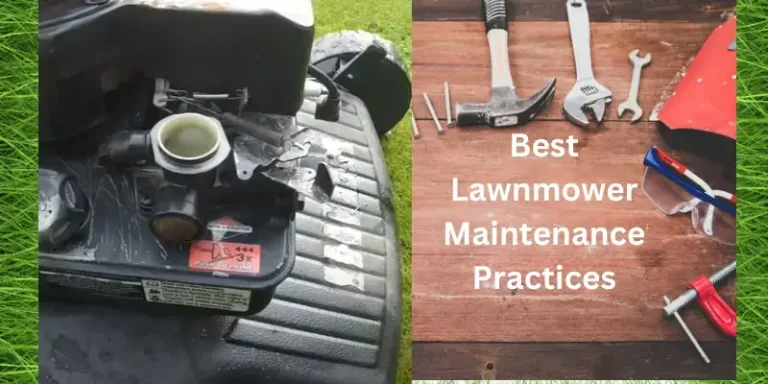Best Ways to Clean your lawnmower Deck
A lawnmower deck, also known as a mower deck or cutting deck is an essential part of a lawnmower that holds the blades and is responsible for cutting the grass. This essential component plays an important role in the cutting of grass. If your mower deck is not cleaned, the mowing quality is not up to mark.
So,
In this blog, I will provide you with all the necessary information and guide you regarding the Cleaning of lawn mower decks. Provide you with the best ways to perform this task easily on your own. I tried to write the simple steps that you follow easily and which resultantly clean your deck.
Why Cleaning Your Lawn Mower Deck is Important?
The lawnmower deck holds the blades and cuts the grass efficiently. When you are using it continuously without cleaning the deck is filled with grass clippings, dirt, and debris which ultimately decreases the speed of moving blades, and your grass is not properly trimmed.
Additionally, if you are not cleaning the deck for a long time, the rust can ruin the deck, the life of your lawnmower life is decreased and different parts are damaged due to rust in the body.
Step-by-Step Guide for Cleaning Lawn Mower Deck
Step 1: Prepare the Lawn Mower: In the first step you must ensure safety. Properly turn off the mower supply and remove the spark plug if you are convenient. Similarly, park the mower in a straight place where the mower is completely balanced. Uneven places might disturb your work.
Step 2: Tilt Your Lawn Mower: Now tilt the lawnmower on its side for easy access to the deck. Be careful not to tilt the carburetor to avoid oil leakage..
Step 3: Removing the Debris Inside Deck In the third step start removing the debris using a wire brush, and gently scrape away the grass clippings, dirt, and stuck-on debris. Do not work in a hurry, gently remove all the dirt below the deck.
Step 4: Clean Properly: In this step use water and wash it thoroughly. Do not leave any space without cleaning. Give a complete shower but be careful to avoid water going inside the electrical wires in case of riding a lawnmower.
Step: Re-install the Deck: In this last and final step you can’t wait until it is completely dry. Now you can put it back in the straight position. To protect from rust apply a coat of silicon spray. This helps you prevent rust for a longer time.
Tips and Tricks For Making The Cleaning Process Easy and Smooth:
Pre-Cleaning Preparation:
Choose the Right Time:
Advise readers to clean their lawnmower deck right after mowing, as the debris will be easier to remove before it dries and hardens.
Select an Appropriate Location:
Recommend cleaning in an area where the mess won’t be an issue, like on grass or over a tarp.
Efficient Cleaning Tools:
Use a Hose with an Attachment:
Suggest using a hose with a pressure nozzle for effective removal of stuck grass and debris.
Specialized Cleaning Products:
Mention specific cleaning products designed for lawnmowers that help break down grass and dirt more effectively.
Safety First:
Wear Protective Gear:
Emphasize the importance of wearing gloves and possibly goggles to protect against debris.
Disconnect the Spark Plug:
Remind readers to always disconnect the spark plug before starting the cleaning process to prevent accidental starting.
Effective Cleaning Techniques:
Scraping Tools:
Advice on the use of plastic scrapers or putty knives to gently remove caked-on grass and mud without damaging the deck.
Use of Lubricants:
Mention how applying a lubricant after cleaning can help prevent debris from sticking in the future.
Routine Maintenance Tips:
Regular Cleaning:
Encourage readers to clean the deck regularly to prevent build-up and extend the life of their lawnmower.
Check for Damage:
Suggest inspecting the deck for any damage or wear during cleaning.
Eco-Friendly Practices:
Responsible Disposal of Waste:
Guide readers on how to responsibly dispose of the grass and debris removed from the deck.
Water Usage:
Offer tips on minimizing water usage, like using a bucket of water for initial washing before using a hose.
Common Mistakes While Cleaning Deck and How to Avoid Them
Common mistakes that every homeowner and gardening professional makes during deck cleaning of lawnmowers. Let’s discuss and find the solution:
Using Inappropriate Tools:
Mistake:
Using metal tools that can scratch or damage the deck.
Solution:
Advice using plastic scrapers or brushes specifically designed for cleaning mower decks to avoid damage.
Applying Excessive Pressure:
Mistake:
Applying too much pressure while scraping off debris, which can bend or damage the blade or deck.
Solution:
Recommend gentle, consistent pressure and remind readers that it’s better to pass over an area multiple times than to use excessive force.
Improper Reassembly:
Mistake:
Forgetting to reassemble all parts correctly, which can lead to accidents or mower malfunction.
Solution:
Suggest taking photos before disassembly for reference, and double-checking all parts are securely reattached.
Ignoring Safety Precautions:
Mistake:
Neglecting to disconnect the spark plug, which can lead to the accidental starting of the mower.
Solution:
Emphasize the importance of safety first, including disconnecting the spark plug before starting any maintenance work.
Water Damage:
Mistake:
Using too much water or directing water towards sensitive parts like the engine or electrical components.
Solution:
Advice using water judiciously and avoiding direct spray on the engine or electrical parts. Mention water-resistant covers if necessary.
Neglecting Blade Care:
Mistake:
Forgetting to check and maintain the blade while cleaning the deck.
Solution:
Encourage checking the blade for sharpness and balance, as a dull or unbalanced blade can harm the mower’s performance.
Improper Drying:
Mistake:
Leaving the deck wet after cleaning, can lead to rust and corrosion.
Solution:
Suggest thoroughly drying the deck after washing, using a towel or a leaf blower.
Using Harsh Chemicals:
Mistake:
Use strong, corrosive cleaning agents that can damage the mower’s paint and metal.
Solution:
Recommend mild detergents or cleaners specifically designed for use on lawnmowers.
Keeping Your Mower Deck Rust-Free
A clean mower deck is more than just pleasing to the eye; it’s your first line of defense against rust. Here’s how to keep it in great shape:
Clean After Every Use: Spend a few minutes cleaning the deck after you mow. This small step can prevent rust from setting in.
Regular Rust Checks: Make checking for rust part of your routine. Catching it early means you can deal with it easily.
Use a Rust Protector: Find a good spray that stops rust. A quick spray now and then can save a lot of trouble later.
Silicone Spray for a Smooth Mow
A little silicone spray can greatly affect your mower’s performance. Here’s what you need to know:
Stops Grass from Sticking: A quick spray underneath keeps grass clippings from sticking, which means less cleaning.
Easy Application: After cleaning the deck, just spray a bit of silicone underneath. It’s that simple.
Smoother Operation: Not only does it keep things clean, but it also helps your mower work better and last longer.
Tightening Blades for Optimal Cutting
The secret to a perfectly mowed lawn is well-maintained blades. Here’s how to ensure they’re always ready:
Regular Tightening: Lawn mower Blades, spindles, and pulleys must be tight. Check them often, especially before you start mowing.
The Right Tools Make a Difference: Using the correct tools for tightening can help you get the job done right without overdoing it.
Safety Comes First: Always disconnect the mower’s power source before you start. Safety is paramount.
Dealing with Stubborn Dirt
Hard, baked-on dirt can be a nuisance, but with the right approach, it’s manageable. Here’s a deeper dive into getting your deck clean:
Soak, Then Scrub: Letting the deck soak with soap and water can loosen up even the toughest grime, making it easier to scrub away.
Gentle Scraping: A putty knife or a plastic scraper can be your best friend here. Just be gentle to avoid scratching the deck.
Make It a Habit: Regular cleaning prevents dirt from building up and becoming a bigger problem.
Expanding on these maintenance tips aims to make lawn mower care feel less like a chore and more like a simple part of your gardening routine. With these strategies, not only will your mower perform better, but it’ll also last longer, saving you time and money in the long run.
FREQUENTLY ASK QUESTIONS (FAQs)
How do I drain gas from a lawn mower without a siphon?
To drain gas from a lawn mower without a siphon, you can tilt the mower on its side to access and remove the fuel line or use a siphon pump to extract the gas from the tank.
When do I need to drain the gas from my lawn mower?
It’s recommended to drain the gas from your lawn mower at the end of the mowing season or if the mower needs to be winterized to prevent fuel system issues.
What are the steps to drain gas from a lawn mower?
The steps to drain gas from a lawn mower include disconnecting the spark plug wire, locating the fuel line and disconnecting it, draining the tank, and ensuring it’s refueled or stabilized for storage.
Can I drain the gas from my lawn mower’s fuel tank on my own?
Yes, you can drain the gas from your lawn mower’s fuel tank on your own by following proper safety precautions and using the correct methods to avoid spills and ensure proper maintenance of the mower.
How do I drain the gas from my lawn mower’s engine?
To drain the gas from your lawn mower’s engine, you need to disconnect the spark plug wire and then either tilt the mower to access and remove the fuel line or use a siphon pump to extract the gas from the tank.
Do I need to drain the gas from the mower’s tank every time before storing it?
It’s advisable to drain the gas from the mower’s tank if it needs to be stored for an extended period to prevent fuel-related issues and ensure proper functioning when it is re-used.
What precautions should I take when draining gas from a lawn mower?
When draining gas from a lawn mower, it’s important to disconnect the spark plug wire to prevent accidental engine starts, avoid spills, and use fuel stabilizer if the gas will be stored for a longer duration.
How much gas should be drained from the lawn mower’s tank if it needs to be winterized?
When winterizing a lawn mower, it’s recommended to drain the tank completely or using a siphon pump to remove as much gas as possible to prevent fuel-related issues during storage.
Should I drain the gas from the lawn mower’s tank if I plan to refuel it soon?
If you plan to refuel the lawn mower soon, there is no need to drain the gas from the tank unless the fuel has deteriorated or you want to use a different type of fuel.
How do I reconnect the spark plug wire and fuel line after draining the gas from the lawn mower?
After draining the gas from the lawn mower, reconnect the spark plug wire and fuel line, ensuring they are properly connected and secure to prevent any fuel or ignition issues during operation.
Conclusion
I will make it easy for you in simple five steps for cleaning your deck. I have noticed that people have not cleaned mower decks for months and years. The rust can cover the deck area and damage the mower body.
The above-written steps provide you with the best ways to clean the lawn mower deck on your own without any hurdles. If you have any queries feel free to email us.

About Naveed A Hashmi
In my childhood, I used to see my parents while working in the land, for these reasons today I have been serving the same as our own tradition and culture. I thus love to stay in it, because I want to learn something advanced and new so that I may improve my farm’s contour and help others with my experience.







